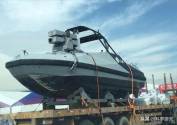Let me try to boil down the discussions and arguments.
What Type 22 missile boats were designed for.
They were meant to get very close to the enemy ships, shoot the missiles and run. That's why they were small, fast and numerous. The context and underlying assumptions were enemy has stronger navy and PLAN does not have air supremacy and sea control, at least there were no guarantee of them. They would be more autonomous than relying on system support such as senor and targeting information. In other words, it's more like guerilla war on the sea, something that PLAN had been very familiar with when dealing with a stronger ROCN since the '50s. It's a strategy that may work when you don't have many other better platforms.
I don't really agree with this -- I think the Type 22s were always designed to stay relatively far away from their opposing ships (100km+ at least) and would fire their AShMs at those ranges ideally supported by offboard ISR.
Their small signature and speed and operating in the littorals, in addition to using AShMs with 180km range (when they first entered service) would be their primary method of maximizing survivability while also being able to inflict casualties on the enemy.
As newer YJ-83 variants have entered service with steadily increasing range, the utility of the Type 22s in that mission role has only expanded, especially as more modern YJ-83 variants also possess land attack capability.
How Type 22 missile boats would be used today.
Option A. Adopt the same strategy that they were designed for. It should still work. But context and condition have all changed. PLAN/PLAAF now have far more efficient and effective platforms and strategy to handle the much weaker and much smaller ROCN.
Option B. Still employ these missile boats but with a different somewhat tactics. This time use them more as mobile AShMs launchers, but keep them farther away from enemy ships. They will be fed with targeting data, but much of the searching and targeting are done by other platforms (aircraft & more capable surface combatants). This will also work. This sounds like what you're suggesting, more or less. My question is if other platforms can do both the searching and targeting AND striking, in a more timely manner, why do you need to use these missile boats? It's not like ROCN has either a qualitative or numerical edge, using PLAAF and/or PLAN larger ships are just much more effective given that PLAAF and PLAN will definitely gain air and sea control over Taiwan Strat.
There is also the fundamental and underlying assumption: the next Taiwan Strait crisis, if these missile boats were deployed and used, world be the armed unification, in which case time is of essence and ROCN ships would need to be destroyed or incapacitated quickly to clear the way for landing.
All in all, I don't doubt that these missile boats can still be useful, I'm questioning if they should still play important roles if at all.
Can Type 22 missile boats be converted to play a more modern and important role?
This is not essential to the arguments. It's something I was thinking prompted by your arguments. We agree it's not worth it for the Taiwan contingency.
I think our views differ as to what the "original" role of the Type 22s were, which is why we disagree here.
I view the Type 22s as being designed from the outset as a FAC intended to engage enemy ships at over 100km away relying on offboard ISR, so in a Taiwan contingency they would be fulfilling the same role as they were designed for -- except of course the YJ-83 variants today have longer range with some land attack capability, and the PLA has much more and varied anti shipping platforms and ISR capabilities now so the Type 22s are really there just to add additional "rofl firepower" to the PLA side at relatively low risk and low cost, with minimal modifications needed.
Let's say the PLA has 8 Type 22s off the coast of Fujian in the conflict. That's basically 64 on call additional AShMs or medium range LACMs they can call upon to strike targets at sea or on the west coast of Taiwan island, at short notice.
Now, it seems to me what you're asking is how does the opportunity cost of it pan out -- i.e. is the money spent on supporting the Type 22 fleet in peacetime and operating them in wartime, better spent elsewhere?
And imo we can't really answer that without knowing what its various costs and manpower demands actually are.


